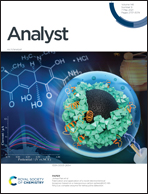Development of a focused high-energy macromolecular ion beam†
Abstract
In this work, we report the development of a focused macromolecular ion beam with kinetic energy of up to 110 keV. The system consists of a quadrupole ion trap (QIT), einzel lens and linear accelerator (LINAC). Based on the combination of matrix-assisted laser desorption ionization (MALDI) and quadrupole ion trapping (QIT), ions were desorbed from the surface and trapped with an ion trap to form biomolecular ion packets. Positive- and negative-pulsed voltages were applied on each end-cap electrode of the QIT to extract the ion packets and form an ion beam that was subsequently focused via an einzel lens and accelerated by stepwise pulsed voltages. The tabletop instrument was designed and successfully demonstrated via measurements of molecular ions of insulin, cytochrome c and bovine serum albumin (BSA) with mass-to-charge ratios (m/z) ranging from ∼5.8 to 66.5 k. This is the first report of both a focused and high-kinetic-energy protein ion beam. In addition, both secondary ions and electrons were observed from the surface by hypervelocity ion beam bombardment. This focused macromolecular ion beam has demonstrated its potential in the study of interactions between large molecular ions with other molecules either in the gas phase or upon a surface.



 Please wait while we load your content...
Please wait while we load your content...